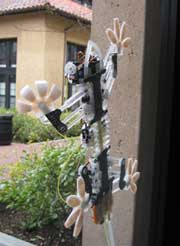 Advanced Telecommunications Research Institute International and Honda Research Institute have developed a new “Brain Machine Interface” for manipulating robots using brain activity signals. Natural brain activity is decoded and the data is used for the near real-time operation of a robot without an invasive incision of the head and brain.
Advanced Telecommunications Research Institute International and Honda Research Institute have developed a new “Brain Machine Interface” for manipulating robots using brain activity signals. Natural brain activity is decoded and the data is used for the near real-time operation of a robot without an invasive incision of the head and brain.
This research reveals that MRI-based neural decoding can allow a robot hand to mimic the subject’s finger movements (“paper-rock-scissors”) by tracking the hemodynamic responses in the brain. Although there is an approximate 7-second time lag between the subject’s movement and the robot’s mimicking movement, the researchers succeeded in gaining a decoding accuracy of 85%.
Via News on Japan > Japan Times.
A Gecko-like robot with sticky feet could soon be scampering up a wall near you. Video of the robot in action.
Stickybot, developed at Stanford University, has feet with synthetic setae made of an elastomer. These tiny polymer pads ensure a large area of contact between the feet and the wall, maximising the stickiness.
The Pentagon is interested in developing gecko-inspired climbing gloves and shoes. A Stickybot-type robot would also make an adept planetary rover or rescue bot.
Via New Scientist.
Finally, Danish director Phie Ambo is making a documentary on Japan’s therapeutic Paro robot, which looks like a baby harp seal, to show how “the world’s most soothing robot” helps patients.
Via the Japan Times.
